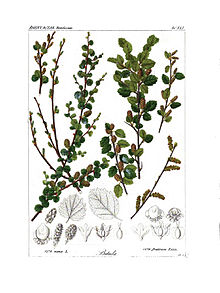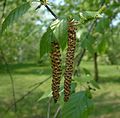Birch
![]()
The title of this article is ambiguous. For other meanings, see Birch (disambiguation) and Birch (disambiguation).
![]()
Betula is a redirect to this article. For the ferry built in 1968, see Betula (ship).
The birches (Betula) form a genus of plants in the birch family (Betulaceae).
The word birch (from Old High German bircha) can be traced back to a term in Indo-Germanic (*bherHg̑o) and, alluding to the light-coloured bark, means something like "shiny, gleaming" (cf. still Middle High German bereht, English bright, -brecht (as a component of the name) "shining").
Description
Vegetative characteristics
Birch species are deciduous, deciduous trees or shrubs. They belong to the very fast and tall-growing woody plants and can reach heights of up to 7 metres after only six years; when fully grown they can grow up to 30 metres, in individual cases even higher. They grow with single or often multiple stems. Individual specimens can reach an age of up to 160 years.
In many birch species, the bark is particularly conspicuous, its colour ranging from almost black to dark and light brown to white; it is initially smooth, later thin, often papery pieces detach, and finally it cracks horizontally. There are often distinct, mostly dark lenticels, which sometimes enlarge horizontally.
The light and, depending on the species, soft to more or less hard wood is almost white to reddish-brown with fine grain. In young twigs, long and short shoots can be distinguished. The twigs are sometimes fragrant. Several smooth scales overlap in the winter buds.
The alternate, usually two-rowed leaves, often arranged on short shoots, are divided into petiole and leaf blade. Depending on the species, the leaf blades are ovate to delta-shaped, elliptical or almost circular, with lengths of 0.5 to 10 (rarely up to 14) centimetres and widths of 0.5 to 8 centimetres, and are glabrous to variably hairy, sometimes resinous-glandular. Pinnate veins are present. The leaf margins are serrate to usually double serrate, depending on the species, or more rarely wavy to slightly round-lobed in the northern dwarf shrub species. The stipules often fall off early.
Generative characteristics
All birch species are monoecious (separate sexes). The inflorescences are called catkins, with the female ones below the male ones on the twigs. The male inflorescences hang singly in small groups usually at the ends of the branches. They are formed in the previous growing season and can already be seen during the winter. There are always three flowers per scale in the male catkins. The male flowers contain only usually two to three (one to four) stamens with filaments divided near their base almost to the anthers. All birches are wind-pollinated (anemophilous), so they release large amounts of pollen during the flowering season from late March to late April. The persistent, female inflorescences are usually solitary and erect, and are ovoid to cylindrical. At the same time as the leaves begin to sprout, the female inflorescences, which were previously protected in buds, fully form. In the female catkins there are rarely one to usually three flowers per scale (bracts).
The erect to pendulous inflorescences have thickened and leathery, but not woody, scales. The scales usually fall off one by one when the seeds are released, or in a few species they remain in the fruiting head through the winter. Winged nut fruits (samara) are formed. On two sides of the seeds are membranous wings, more or less broad. The fruits ripen from September to October.
The basic chromosome number is x = 14.
·
Catkins of the Himalayan birch (Betula utilis)
· 
Ripe fruit of the grey birch (Betula populifolia)
· 
Ripe fruit of the sugar birch (Betula lenta)
· 
Winged nut fruit of the pendulous birch (Betula pendula). The small wings transport the fruits over long distances.

Illustration of Betula nana (left half) and Betula fruticosa (right half)
Importance for pollen allergy sufferers
Birch pollen is a highly potent allergen. According to the ENT Clinic of the University of Vienna, the proportion of allergy sufferers who react specifically to birch pollen has risen from 35 % to 50 % of all early blossom allergy sufferers in the last 20 years. Nevertheless, birch trees are often planted as avenue trees in cities because of their beautiful white colouring. As with all pollen, birch pollen counts change slightly each year. In Germany, they appear annually from about the end of March to the beginning of June, with the main flowering occurring about 2 weeks in mid-April.
Search within the encyclopedia
